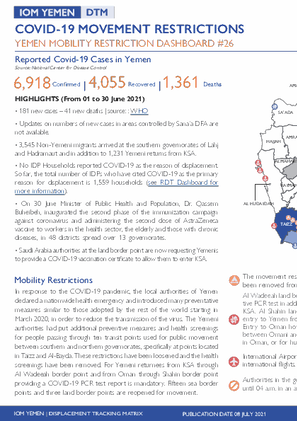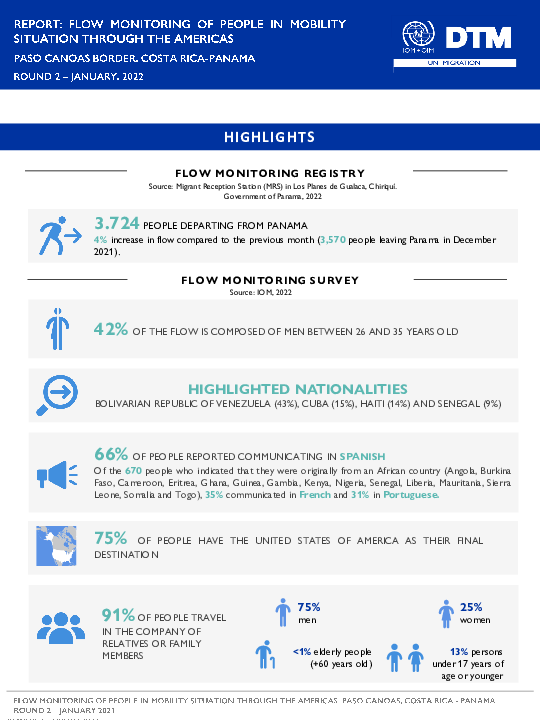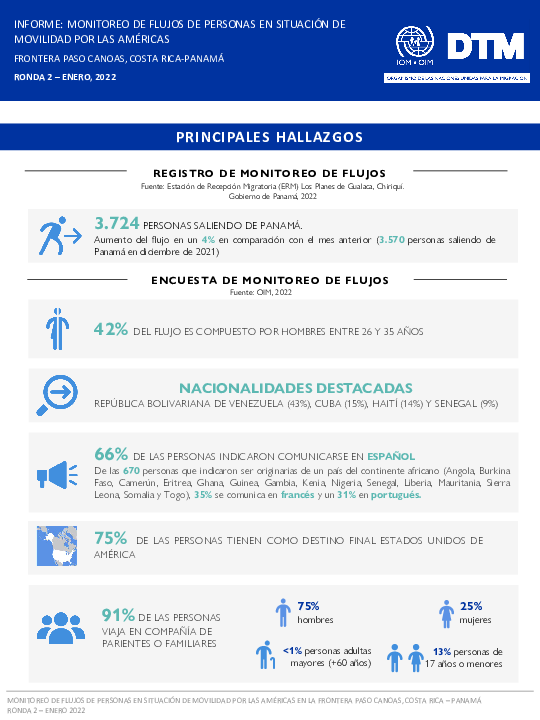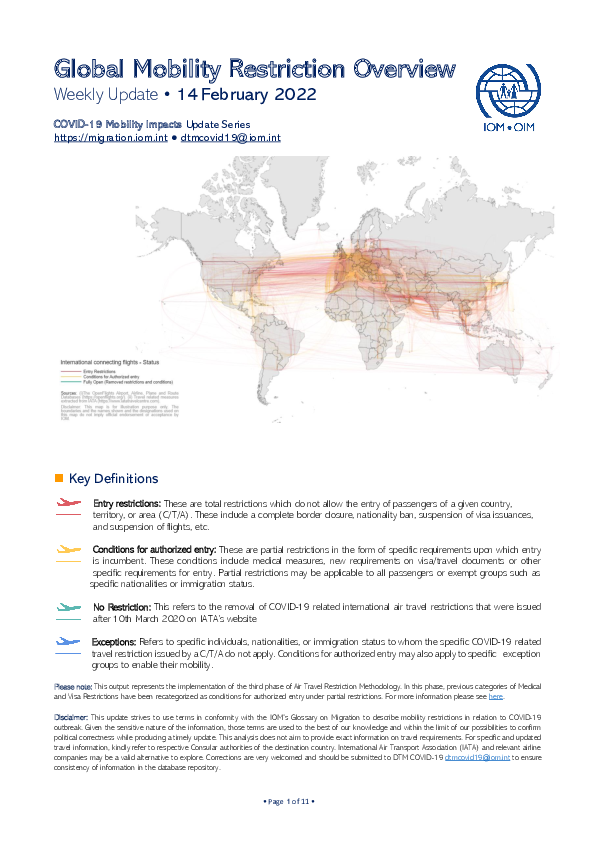-
Countries
-
Data and Analysis
-
Special Focus
-
Crisis Responses

Contact
DTM Yemen, iomyemendtm@iom.int
Language
English
Location
Yemen
Period Covered
Jun 01 2021
Jun 30 2021
Activity
- Mobility Tracking
- Points of Entry (PoE)
HIGHLIGHTS (From 01 to 30 June 2021)
• 181 new cases – 41 new deaths | source: WHO
• Updates on the numbers of new cases in areas controlled by Sana’a DFA are not available.
• 3,545 Non-Yemeni migrants arrived at the southern governorates of Lahj and Hadramaut and in addition to 1,231 Yemeni returns from KSA.
• No IDP Households reported COVID-19 as the reason of displacement. So far, the total number of IDPs who have cited COVID-19 as the primary reason for displacement is 1,559 households (see RDT Dashboard for more information).
• On 30 June Minister of Public Health and Population, Dr. Qassem Buheibeh, inaugurated the second phase of the immunization campaign against coronavirus and administered the second dose of AstraZeneca vaccine to workers in the health sector, the elderly and those with chronic diseases, in 48 districts spread over 13 governorates.
• Saudi Arabia authorities at the land border point are now requesting Yemenis to provide a COVID-19 vaccination certificate to allow them to enter KSA.

Contact
DTMMozambique@iom.int
Language
English
Location
Mozambique
Period Covered
Feb 09 2022
Feb 15 2022
Activity
- Event Tracking
- Mobility Tracking
During the reporting period (09 to 15 February 2022), a total of 45 movements were recorded – 39 Arrivals (1,885 individuals), 1 transit (63 individuals) and 5 departures (126 individuals). The largest arrival movements were recorded in Nangade (697 individuals), Cidade de Pemba (619 individuals), Montepuez (214 individuals), and Metuge (142 individuals). The largest departure was observed in Mueda (53 individuals). Of the total population captured by the ETT, 78 per cent were displaced for the first time, and 22 per cent of reported IDPs had been displaced more than once prior to this latest movement.

Contact
dtmsudan@iom.int
Language
English
Location
Sudan
Snapshot Date
Feb 20 2022
Activity
- Event Tracking
- Flow Monitoring Survey
- Registration
- Flow Monitoring
DTM is a system to track and monitor displacement and population mobility. It is designed to regularly and systematically capture, process and disseminate information to provide a better understanding of the movements and evolving needs of displaced populations, whether on site or en route. Data collection strategies and tools are based on the DTM global methodology but have been adapted to reflect the context and population movements specific to Sudan.
This product outlines DTM's methodological components operating currently in Sudan namely, Mobility Tracking, Early Warning Flash Alerts and Emergency Event Tracking, Situation Assessments, Registration Activities, Flow Monitoring Registry and Integrated Location Assessment.

Contact
Angelica Madrigal amadrigal@iom.int / Miranda Mora mmora@iom.int
Language
English
Location
Costa Rica
Period Covered
Jan 01 2022
Jan 31 2022
Activity
- Survey
- Flow Monitoring
Within the framework of the COVID-19 emergency, since March 19, 2020, the Government of Costa Rica has kept its land border with Panama closed, and the Binational Controlled Flow Operation, agreed between the governments of Costa Rica and Panama at the Paso Canoas border to ensure an orderly and safe migration of migrants moving through the Americas, was stopped. As of the date of this report, there is no approximate date for its reimplementation.
Given the presence of this irregular migration flow, since August 24, 2021, IOM Panama has published information on the irregular migration flow in Darien, Panama under the context of COVID-19. Based on this information, it has been identified that during 2021 the flow of people in a situation of mobility through the Americas with destination to North America is on the rise: according to SNM data, in the period between August and November 2021, the irregular entry of 126,675 migrants of different nationalities has been registered at the border between Colombia and Panama: Haiti (62%), Cuba (13%), Chile (8%), Brazil (7%), Bolivarian Republic of Venezuela (2%), among other countries in South America, Africa and Asia.
In Costa Rica, an increase has been identified in the number of migrants from the migration flow who decide to stay in the country, mainly people from Haiti, who, in some cases, have requested refuge in the country before the General Directorate of Migration and Foreigners (DGME). According to data from the DGME, between May and December 2021, 4,296 rejections were carried out in Paso Canoas.

Contact
Angelica Madrigal amadrigal@iom.int / Miranda Mora mmora@iom.int
Language
Spanish
Location
Costa Rica
Period Covered
Jan 01 2022
Jan 31 2022
Activity
- Survey
- Flow Monitoring
En el marco de la emergencia por la COVID-19, desde el 19 de marzo del 2020, el Gobierno de Costa Rica mantiene cerradas su frontera terrestre con Panamá para la Operación Binacional Flujo Controlado, acordado así entre los gobiernos de Costa Rica y Panamá en la frontera de Paso Canoas para procurar una migración ordenada y segura de personas migrantes en situación de movilidad por América, se detuvo. A la fecha de este Informe, no se cuenta con una fecha aproximada para su reimplementación.
Ante la presencia de este flujo migratorio irregular, desde el 24 de agosto de 2021, OIM Panamá ha publicado información sobre el flujo migratorio irregular en Darién, Panamá bajo el contexto de la COVID-19. A partir de esta información se ha identificado que durante el 2021 el flujo de personas en situación de movilidad por las Américas con destino hacia Norteamérica se encuentra en aumento: según datos del SNM, en el periodo comprendido entre agosto y noviembre de 2021, se ha registrado en la frontera entre Colombia y Panamá, el ingreso irregular de 126.675 personas migrantes de diferentes nacionalidades: Haití (62%), Cuba (13%), Chile (8%), Brasil (7%), República Bolivariana de Venezuela (2%), entre otros países del Sur de América, África y Asia.
En Costa Rica, se ha identificado un aumento en la cantidad de personas migrantes del flujo migratorio que deciden quedarse en el país, principalmente personas originarias de Haití, que, en algunos casos, han solicitado refugio en el país ante la Dirección General de Migración y Extranjería (DGME). De acuerdo con datos de la DGME, durante mayo y diciembre 2021 se han realizaron 4.296 rechazos en Paso Canoas.

Contact
DTMcovid19@iom.int
Language
English
Location
Global
Snapshot Date
Feb 14 2022
Activity
- Other
The current outbreak of COVID-19 has affected global mobility in the form of various travel disruptions and restrictions. To better understand how COVID-19 affects global mobility, DTM has developed a COVID-19 database mapping the different restrictions to provide a global overview. For this, DTM uses the IATA site as the primary source of restrictions with the information reported per country and territory, and to the country of application.
Data collected includes:
- Date of restriction
- Country, territory or area of restriction
- Countries, territories or areas on which restrictions were imposed
- Type of restriction- total restriction, or conditional restriction – such as medical/ and or visa restriction
This DTM COVID-19 Travel Restrictions Output presents an analysis based on country imposing, the country being imposed upon, and the aggregation of the restriction type. The aim of the data analysis is to provide an overview of the COVID-19 outbreak on global mobility and to help identify and develop responses.

Contact
iomisbdtmremapteam@iom.int
Language
English
Location
Pakistan
Period Covered
Oct 24 2021
Nov 06 2021
Activity
- Flow Monitoring
IOM Pakistan collects data on the outflows of undocumented Afghan migrants at the Torkham and Chaman border crossing points in an effort to better understand the migration movements of undocumented Afghan migrants returning to Afghanistan from Pakistan. This exercise is part of the European Union funded project “Displacement Tracking Matrix Regional Evidence for Migration Analysis and Policy (DTM REMAP)”. From 24 October to 06 November 2021, 1,834 undocumented Afghan migrants returned to Afghanistan, including 415 through the Torkham border point and 1,419 through the Chaman border point. The number of individuals who returned through the Torkham border crossing remained low as restrictions were imposed by the Pakistan Border Authorities in light of the security situation at the border with Afghanistan and the evolving COVID-19 pandemic.

Contact
iomisbdtmremapteam@iom.int
Language
English
Location
Pakistan
Period Covered
Jan 29 2022
Feb 11 2022
Activity
- Flow Monitoring
IOM Pakistan collects data on the outflows of undocumented Afghan migrants at the Torkham and Chaman border crossing points in an effort to better understand the migration movements of undocumented Afghan migrants returning to Afghanistan from Pakistan. This exercise is part of the European Union funded project “Displacement Tracking Matrix Regional Evidence for Migration Analysis and Policy (DTM REMAP)”. From 29 January to 11 February 2022, 2,805 undocumented Afghan migrants returned to Afghanistan, including 311 through the Torkham border point and 2,494 through the Chaman border point. During the reporting period, border authorities facilitated the return of 42 individuals due to the lack of legal documentation to remain in Pakistan. Therefore, information concerning these 42 individuals is not included in the report analysis.

Contact
REMAPBD@iom.int
Language
English
Location
Bangladesh
Period Covered
Jan 01 2019
Dec 31 2019
Activity
- Flow Monitoring
- Migrants presence
According to available data from the Displacement Tracking Matrix (DTM) Europe compiled in the following snapshot by the DTM REMAP project funded by the European Union, 1,952 irregular Bangladeshi nationals arrived by sea and by land in Europe by entering Cyprus, Greece, Italy, Malta or Spain in 2019. The highest share of Bangladeshi nationals was registered in Cyprus (49% of the total arrivals by land and by sea). Additionally, 6,625 Bangladeshi nationals were identified while transiting through the Western Balkan (WB) countries during the same year

Contact
REMAPBD@iom.int
Language
English
Location
Bangladesh
Period Covered
Jan 01 2018
Dec 31 2018
Activity
- Flow Monitoring
- Migrants presence
According to available data from the Displacement Tracking Matrix (DTM) Europe compiled in the following snapshot by the DTM REMAP project funded by the European Union, 804 irregular Bangladeshi nationals arrived by sea and by land in Europe by entering Greece, Italy or Spain in 2018. The highest share of Bangladeshi nationals was registered in Spain (56% of the total arrivals by land and by sea). Additionally, 1,320 Bangladeshi nationals were identified while transiting through the Western Balkan (WB) countries during the same year.
